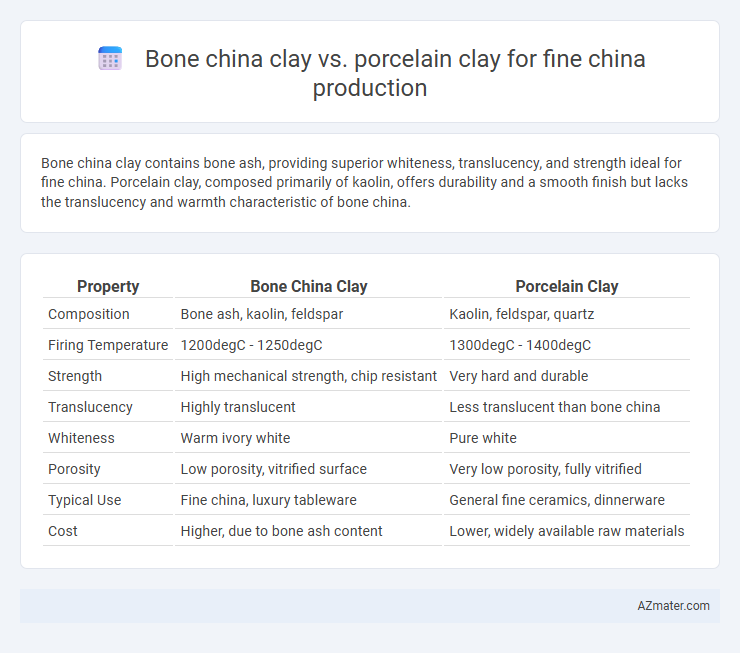Bone china clay contains bone ash, providing superior whiteness, translucency, and strength ideal for fine china. Porcelain clay, composed primarily of kaolin, offers durability and a smooth finish but lacks the translucency and warmth characteristic of bone china.
Table of Comparison
| Property | Bone China Clay | Porcelain Clay |
|---|---|---|
| Composition | Bone ash, kaolin, feldspar | Kaolin, feldspar, quartz |
| Firing Temperature | 1200degC - 1250degC | 1300degC - 1400degC |
| Strength | High mechanical strength, chip resistant | Very hard and durable |
| Translucency | Highly translucent | Less translucent than bone china |
| Whiteness | Warm ivory white | Pure white |
| Porosity | Low porosity, vitrified surface | Very low porosity, fully vitrified |
| Typical Use | Fine china, luxury tableware | General fine ceramics, dinnerware |
| Cost | Higher, due to bone ash content | Lower, widely available raw materials |
Understanding Fine China: Bone China Clay vs Porcelain Clay
Bone china clay contains bone ash, giving it superior whiteness, translucency, and strength compared to porcelain clay, which is primarily composed of kaolin and feldspar. Porcelain clay offers higher firing temperatures and a more vitrified, durable finish but lacks the delicate translucency and lightweight qualities of bone china. For fine china production, bone china is preferred for its elegant appearance and toughness, while porcelain clay is favored for its robustness and versatility in various ceramic applications.
Composition Differences: Bone China Clay and Porcelain Clay
Bone china clay contains a significant amount of bone ash, typically around 25-50%, mixed with kaolin and feldspar, which imparts high translucency and strength to fine china. Porcelain clay primarily consists of kaolin, quartz, and feldspar, lacking any bone ash, resulting in a harder, more vitrified texture with less translucency. The inclusion of bone ash in bone china lowers the firing temperature and increases whiteness and chip resistance compared to traditional porcelain clay.
Manufacturing Process Comparison
Bone china clay requires the integration of bone ash, kaolin, and feldspar, resulting in a longer vitrification process at lower firing temperatures around 1200degC, which enhances translucency and strength. Porcelain clay, primarily composed of kaolin with quartz and feldspar, undergoes firing at higher temperatures between 1300degC and 1400degC to achieve its hardness and durability. The manufacturing process of bone china emphasizes precise blending and controlled lower-temperature firing to maintain its lightweight yet strong characteristics, whereas porcelain's production relies on higher heat exposure for dense, non-porous finished products.
Strength and Durability: Which Clay Prevails?
Bone china clay contains bone ash, which significantly enhances its strength and chip resistance compared to porcelain clay, making it highly durable for fine china production. Porcelain clay, composed primarily of kaolin and feldspar, offers excellent hardness and a translucent quality but generally lacks the toughness provided by bone ash. In terms of strength and durability, bone china clay prevails due to its superior mechanical resilience and resistance to cracking under daily use.
Translucency and Aesthetic Appeal
Bone china clay exhibits superior translucency compared to porcelain clay due to its high bone ash content, which enhances light transmission and creates a delicate, ethereal appearance. Porcelain clay offers a denser, whiter finish but lacks the same level of translucency, resulting in a more solid and opaque aesthetic. The combination of strength and translucent beauty makes bone china the preferred material for luxury fine china production, delivering elegance and visual appeal unmatched by traditional porcelain.
Color and Finish: Contrast Between Clays
Bone china clay offers a translucent, milky-white color with a smooth, glossy finish, enhancing the elegance of fine china. Porcelain clay is typically pure white but can appear slightly more opaque and has a matte to semi-gloss finish depending on the firing process. The contrast lies in bone china's warm ivory tone and higher translucency versus porcelain's bright white and more solid, less luminous surface.
Porosity and Water Absorption
Bone china clay exhibits lower porosity and water absorption rates compared to porcelain clay, resulting in a denser and more durable fine china product. Porcelain clay tends to have higher porosity, allowing increased water absorption, which can affect the strength and translucency of the final ware. These differences influence the selection of clay types based on the desired balance of strength, translucency, and resistance to liquid penetration in fine china production.
Workability for Artisans: Ease of Shaping and Molding
Bone china clay offers superior workability for artisans due to its fine particle size and plasticity, allowing for easier shaping and intricate molding in fine china production. Porcelain clay, while strong and durable after firing, tends to be less plastic and more prone to cracking during the forming process, demanding greater skill and care. The higher bone ash content in bone china ensures a smoother, more malleable consistency, facilitating detailed craftsmanship and delicate designs.
Cost Analysis: Bone China vs Porcelain for Production
Bone china clay incurs higher raw material costs due to its content of bone ash, which enhances translucency and strength, making it more expensive than porcelain clay. Porcelain clay, primarily composed of kaolin and feldspar, offers lower material expenses and faster firing cycles, optimizing production costs. Manufacturers balance the premium price of bone china with its luxury appeal, while porcelain remains cost-efficient for large-scale fine china production.
Choosing the Right Clay for Fine China Production
Bone china clay contains a significant proportion of bone ash, providing exceptional translucency, strength, and whiteness ideal for luxury fine china production. Porcelain clay, composed mainly of kaolin and feldspar, offers high durability and a smooth surface but lacks the delicate translucency of bone china. Selecting the right clay involves evaluating desired characteristics like translucency, strength, and aesthetic appeal to meet the standards of premium fine china.

Infographic: Bone china clay vs Porcelain clay for Fine china production
 azmater.com
azmater.com